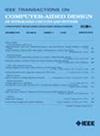RuleLearner: OPC Rule Extraction From Inverse Lithography Technique Engine
IF 2.7
3区 计算机科学
Q2 COMPUTER SCIENCE, HARDWARE & ARCHITECTURE
IEEE Transactions on Computer-Aided Design of Integrated Circuits and Systems
Pub Date : 2024-11-15
DOI:10.1109/TCAD.2024.3499909
引用次数: 0
Abstract
Model-based optical proximity correction (OPC) with subresolution assist feature (SRAF) generation is a critical standard practice for compensating lithography distortions in the fabrication of integrated circuits at advanced technology nodes. Typical model-based OPC and SRAF algorithms involve the selection of user-controlled rule parameters. Conventionally, these rules are heuristically determined and applied globally throughout the correction regions, which can be time consuming and require expert knowledge of the tool. Additionally, the correlations of rule parameters to the objectives are highly nonlinear. All these factors make designing a high-performance OPC engine for complex metal designs a nontrivial task. This article proposes RuleLearner, a comprehensive mask optimization system designed for SRAF generation and model-based OPC in real industrial scenarios. The proposed framework learns from the guidance of an information-augmented inverse lithography technique engine, which, although expressive for complex designs, is expensive to generate refined masks for a whole set of design clips. Considering the nonlinearity and the tradeoff between local and global performance, the extracted rule value distributions are further optimized with customized natural gradients. The sophisticated SRAF generation, the edge segmentation and movements are then guided by the rule parameter. Experimental results show that RuleLearner can be applied across different complex design patterns and achieve the best lithographic performance and computational efficiency.RuleLearner:从反向光刻技术引擎中提取 OPC 规则
具有亚分辨率辅助特征(SRAF)生成的基于模型的光学接近校正(OPC)是补偿先进技术节点集成电路制造中光刻畸变的关键标准实践。典型的基于模型的OPC和SRAF算法涉及用户控制规则参数的选择。通常,这些规则是启发式地确定的,并在整个校正区域中应用,这可能很耗时,并且需要工具的专业知识。此外,规则参数与目标之间的相关性是高度非线性的。所有这些因素使得为复杂金属设计高性能OPC引擎成为一项艰巨的任务。本文提出了RuleLearner,这是一个针对真实工业场景下SRAF生成和基于模型的OPC而设计的综合掩模优化系统。所提出的框架借鉴了信息增强逆光刻技术引擎的指导,该引擎虽然对复杂的设计具有表现力,但为整套设计剪辑生成精致的掩模是昂贵的。考虑到非线性以及局部和全局性能之间的权衡,提取的规则值分布使用自定义的自然梯度进一步优化。然后由规则参数指导复杂的SRAF生成、边缘分割和运动。实验结果表明,RuleLearner可以应用于不同的复杂设计模式,并获得最佳的光刻性能和计算效率。
本文章由计算机程序翻译,如有差异,请以英文原文为准。
求助全文
约1分钟内获得全文
求助全文
来源期刊
CiteScore
5.60
自引率
13.80%
发文量
500
审稿时长
7 months
期刊介绍:
The purpose of this Transactions is to publish papers of interest to individuals in the area of computer-aided design of integrated circuits and systems composed of analog, digital, mixed-signal, optical, or microwave components. The aids include methods, models, algorithms, and man-machine interfaces for system-level, physical and logical design including: planning, synthesis, partitioning, modeling, simulation, layout, verification, testing, hardware-software co-design and documentation of integrated circuit and system designs of all complexities. Design tools and techniques for evaluating and designing integrated circuits and systems for metrics such as performance, power, reliability, testability, and security are a focus.

 求助内容:
求助内容: 应助结果提醒方式:
应助结果提醒方式:


